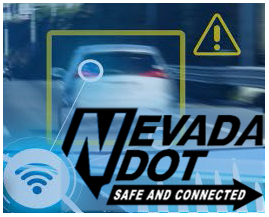 Nevada DOT Research is exploring the feasibility of autonomous vehicles-only lanes as a lower cost solution for tackling excessive congestion in the areas with rapid economic growth. This project was proposed by Cole Mortensen, Assistant Director for Engineering. After the Research Management Committee reviewed and approved this research project, NDOT entered into an agreement with Cambridge Systematics to perform the research study titled “Autonomous Vehicle Feasibility Study” on November 14, 2018.
Nevada DOT Research is exploring the feasibility of autonomous vehicles-only lanes as a lower cost solution for tackling excessive congestion in the areas with rapid economic growth. This project was proposed by Cole Mortensen, Assistant Director for Engineering. After the Research Management Committee reviewed and approved this research project, NDOT entered into an agreement with Cambridge Systematics to perform the research study titled “Autonomous Vehicle Feasibility Study” on November 14, 2018.
This study is intended to be the first step in determining the feasibility of incorporating fully autonomous vehicles on Nevada’s roadways. Does the future of autonomous transportation mean dedicated lanes or fully dedicated roadways? Which is more cost effective? What other options are available? What are the needs of potential users? What are the needs of law enforcement? This study will help use attain needed foundational knowledge to support next steps towards incorporating autonomous vehicle considerations into NDOT projects.
In an age where the future is now, and more of our daily lives are impacted by autonomous features, self-driving autonomous vehicles are taking center stage. A huge part of the autonomous vehicle conversation is determining who are going to use them, and what are the design standards that autonomous-infrastructure will be built around. This study will help NDOT better understand these needs to ensure that we are headed in the best direction to facilitate the future of Nevada’s roadways.
The study is taking place in Northern Nevada, in Washoe and Storey Counties, with a focus area between Reno/Sparks and the Tahoe Reno Industrial Center (TRIC). TRIC has grown rapidly in the past couple years; if the growth continues as anticipated, the amount of daily traffic at peak travel times will exceed the threshold of the main thoroughfare to/from TRIC. This is a prime spot to study the benefits and feasibility of autonomous roadway facilities. An added benefit of selecting this area, is the concentration of high-tech companies located at TRIC who have strong interest in being part of the autonomous transportation discussion.
To this end, Cambridge Systematics and NDOT Research, with the help of NV2X office, held a stakeholder meeting on March 12, 2019, to discuss three initial questions of this research:
- How would you use and benefit from the AV roadway?
- What might be the level of use of the AV roadway?
- How would an AV roadway be implemented?
Stakeholders included private companies from the Reno/Sparks/TRIC area, government agencies, and State entities. The broad range of answers received are informing the research team on not only general concerns that surround autonomous vehicle infrastructure, but also pointed ideas that will help shape the conversation and the future of Nevada’s roadways.
Now we would like to hear from you! Using the comments section below, tell us in addition to the questions above, what are your thoughts on the feasibility of autonomous vehicle infrastructure on Nevada’s roadways? What are your concerns? What are you ideas?